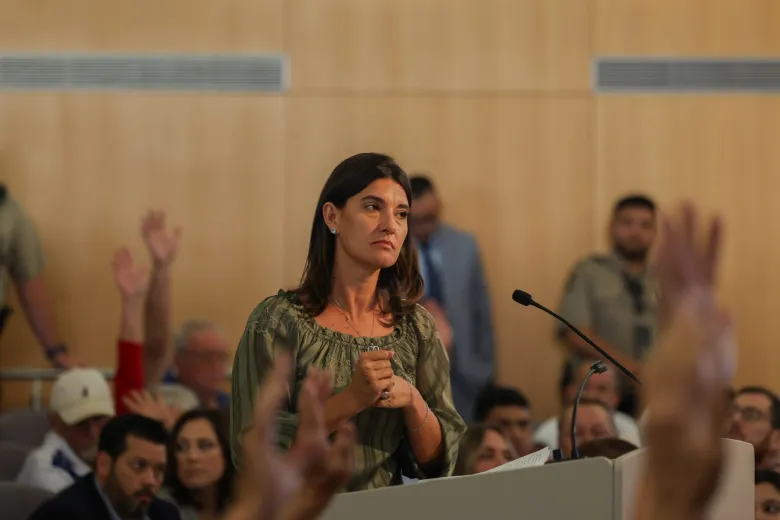Copyright Arizona Capitol Times

Key Points: BNSF Railway’s $3.2 billion project threatens Wittmann residents’ way of life Residents oppose 4,320-acre rail facility, citing noise and environmental concerns Residents fear exposure to particulates and toxins from the proposed facility In the morning, Laura Deaver wakes to the soft hum of the desert land surrounding her home. The calm is occasionally interrupted by the sound of horses snorting or a morning four-wheeler ride with her husband, Kyle, and 7-year-old daughter, Kyrie. Neighbors sip coffee and wave from their porches as the small community of Wittmann begins another day. Now, she says, a project by Burlington-Northern Santa Fe — better known as BNSF Railway and one of the country’s largest railroad companies — threatens the way of life for the town’s roughly 600 residents. “This is the safest, most intimate community you could find,” she said, “Now imagine 15,000 semis coming off of that road you just drove in on.” Deaver is referring to a $3.2 billion construction project for BNSF’s proposed 4,320-acre rail facility that would horseshoe around Wittmann and neighboring areas. Since its announcement in 2024, it has faced waves of backlash. At a Maricopa County Board of Supervisors meeting on Nov. 5, the proposed facility faced another major setback. Wittmann residents packed the room to oppose an amendment designating a portion of land for BNSF project development. BNSF first acquired land along Grand Avenue near Wittmann in 2004 to develop a new intermodal rail facility serving the Phoenix region. As freight demand grew, the company expanded the site to roughly 4,300 acres in 2022. A mapping error during Maricopa County’s 2023 White Tank Grand Avenue Area Plan update reclassified about 840 acres from industrial to single-family rural. BNSF filed an amendment and rezoning request in May 2024 to fix it. After its approval by the Planning and Zoning Commission, the company asked for several continuances to allow for the requests to be presented with finalized agreements. While the board unanimously sided with residents, tensions still ran high. Deaver, whose home will be nestled up against the industrial giant with only a small fence separating her from the construction site, spoke for many opposing the project. “They’re filling people full of false hope,” Deaver said. According to BNSF, the project, formally titled Logistics Park Phoenix, will include a rail-served terminal, a logistics center and a logistics park. The proposal says the project will bring upward of 76,000 jobs during and after construction. Residents from Wittmann and the surrounding communities made clear at the meeting they are opposed to the proposal. “I’d like to ask if someone can tell me how our lifestyle and our lives are so disposable,” said Wittmann resident Patricia Van Eck to the board. Many residents cited what they described as BNSF’s inconsistent track record with environmental precautions. In 2024, a federal judge ordered the company to pay close to $400 million to the Swinomish tribe in Washington for trespassing and carrying hundreds of cars’ worth of crude oil across tribal land. Also in 2024, environmental groups sued BNSF for releasing large volumes of plastic nurdles from freight cars into coastal lagoons and the Pacific Ocean. They said the nurdles, the plastic pellets used to make disposable plastic products, caused ongoing toxic pollution that harms marine ecosystems. BNSF also faced a lawsuit from residents of Libby, Mont., for negligence and contributing to fatal cases of asbestos-related illnesses. Some Wittmann residents said they fear the same fate at the meeting. One speaker, Rick Sanetra, who said he uses supplementary oxygen due in part to past exposure to asbestos, worries others may follow in his footsteps. “It bothers me that our kids, our animals, our parents will all be exposed to particulates out there,” Sanetra said. Another resident, Kirby Anderson, said they are not opposed to the project, but rather its location. He questioned the project’s transparency and said the lack of planning outweighs the benefits — a sentiment the board seemed to share. “Another location may suit all stakeholders better, which BNSF should investigate harder,” Anderson said. During her presentation, BNSF legal representative Susan Demmitt answered some of these questions and highlighted the economic benefits of the major project. “Over time, the population of the region has continued to grow, and with it, the need for expanded transportation and supply-chain infrastructure,” Demmitt said. Three labor union representatives supported the amendment and the project. They said it would bring jobs and support small-town economies, such as Wittmann. Joshua Lemley, a member of Carpenters Local Union 1912, said the project was about building the middle class. “It’s not just about rail. It’s about putting skilled tradespeople to work and keeping Arizona’s economy on track,” Lemley said. He and other supporters highlighted the country’s evolving supply chain and the need for the state to keep pace. The project would help modernize regional freight movement, strengthen the state’s role in the national logistics network and keep distribution efficient, they said. “We all love getting our Amazon packages, our medicine, and our groceries delivered on time,” said union member and former state representative Mark Cardenas. “Projects like this make that happen. Logistics Park Phoenix is how the modern supply chain actually works — fast, efficient, and reliable.” Nearly 30 speakers came out in opposition to BNSF’s amendment. They said they want Wittmann to remain the way it is. Community member Robin Jones gave emotional testimony from the podium. Next to her, Deaver stood holding a poster board she had made with her daughter. It was a map. Each day, the mother-daughter duo eagerly filled it with tiny red squares. Each little square represented a Wittmann resident who said no to BNSF’s project. “The map began as just a way to stay organized, but it became something much more,” Jones said. “It became proof of what we already knew. Our community does not want to be surrounded, overshadowed and impacted by this project. Not today, not tomorrow, or ever.” Deaver also read a note from Kyrie. “Dear Board of Supervisors, I don’t like the railroad because I won’t get enough sleep at night,” It read. “And in the morning, I will be grumpy. Love, Kyrie.” Among the opposition are Sen. Janae Shamp, who represents the legislative district encompassing Wittmann; the Nadaburg Unified School District; and Sun City West Property Owners and Residents Association, which represents approximately 40,000 residents. “I appreciate the applicant’s willingness to engage and adjust. We’ve been in many meetings together,” said District 4 Supervisor Debbie Lesko, who led the board’s opposition. “But we have reached a point where additional delay will not change the fundamental reality that the infrastructure and service framework necessary to support this level of development is not in place.” While they did not respond for comment, in a statement after the board meeting, BNSF said it remains undeterred. “We are confident that LPP is the best way to serve our customers, as well as the Arizona residents and businesses that depend on the goods we transport, while maximizing the benefits of rail,” the company said about Logistics Park Phoenix. While the Nov. 5 vote was a win for the residents of Wittmann opposing the project, the fight is far from over. “This is a small win,” Deaver said, “We’d be fools to think this is over.” For Deaver, the decision is one step closer to keeping her morning horse rides and Kyrie’s neighborhood playdates. Her parting message to BNSF contained a touch of hospitality. “Come visit,” she said, extending an invitation to BNSF leadership. “We’ll jump in the side-by-side. I’ll take you out, and I can show you exactly how we live.”



